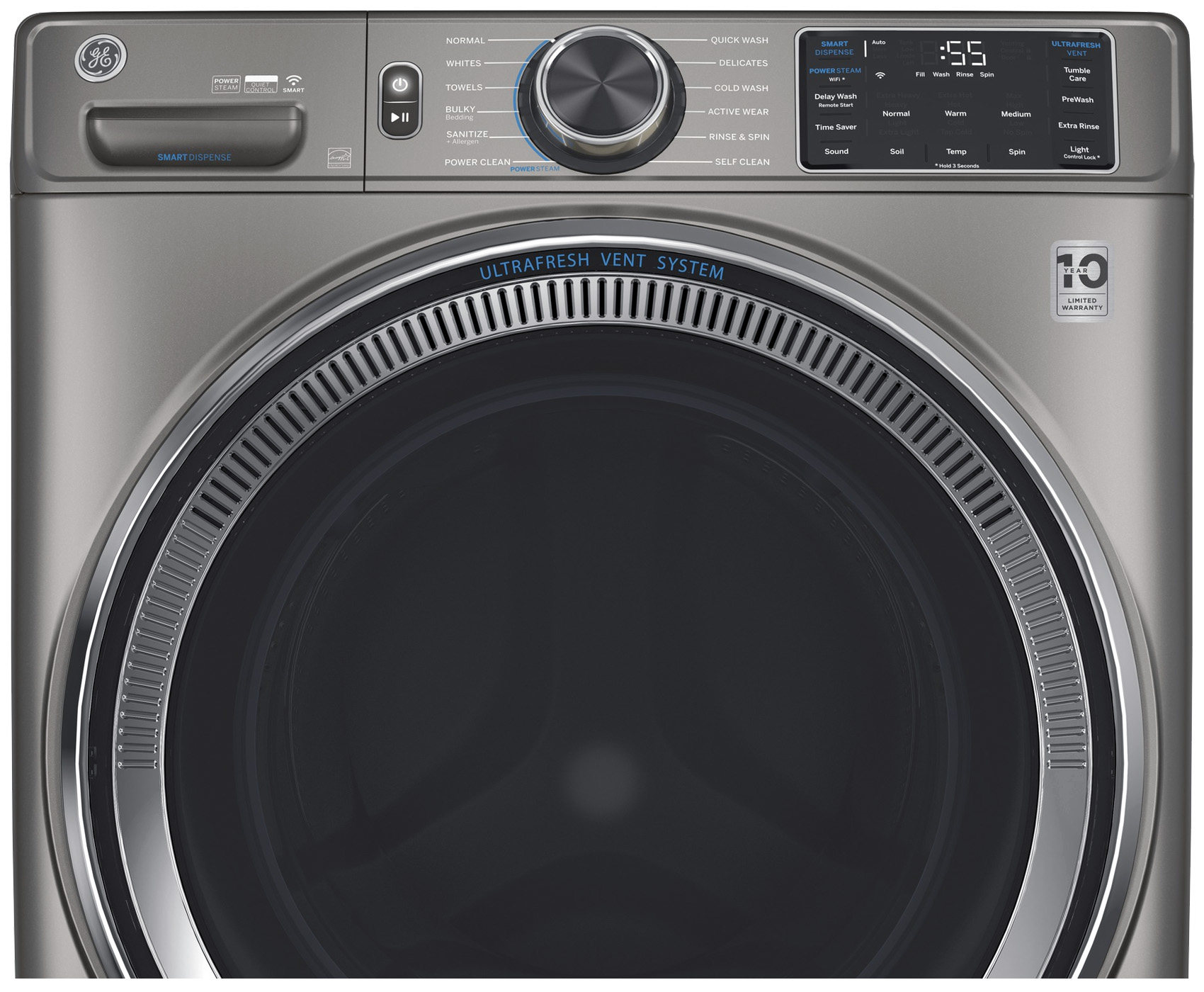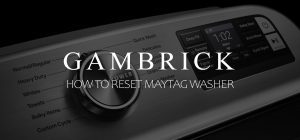GE Washer Won’t Start Cycle
There are a variety of reasons why your GE washer won’t start. To fix the problem and get your washing machine running again, you should troubleshoot each potential issue, starting with the simplest and most common problems first. The most common reason why a GE washer won’t start is the door latch. If the door isn’t closed properly and the latch doesn’t engage, the washer won’t start. Make sure the door seal or clothing isn’t interfering with the door. Next, check the power supply. Inspect the power cord for damage and make sure it’s connected to the washer correctly, then check the outlet and your breaker or fuse panel. If the washer isn’t receiving power, it won’t start.
Here’s a summary of other potential problems that can cause a GE washer not to start:
- The washer door latch isn’t engaged; fix it by closing the door firmly or checking the door switch.
- A power issue, such as a blown fuse or circuit breaker, an issue with the power cord, or a bad wall outlet.
- Faulty timer, user control, display board, or line fuse.
- Malfunctioning spin belt or a clogged water pipe.
- A locked control panel, unlock it by pressing and holding the lock button for 3 seconds.
- The wrong cycle setting, fix it by selecting the appropriate cycle and options.
- A defective washer part, such as the lid switch, the door lock, the start switch, or the main control board.
- Overload protection, fix it by taking some clothing out of the washer.
- Make sure the washer isn’t paused.
- Check if the washer has a delay start feature that’s active.
I’ve dealt with a lot of GE washers that won’t start in my career, and it’s usually a simple fix to get them started again.
Troubleshooting A GE Front Load Washer Not Starting
Troubleshooting a GE washer that won’t start is a fairly easy process. Most of the reasons why it won’t start are simple things to check, like settings, the power supply, and the door latch. I recommend going through the list one at a time, starting with the easiest potential issues to diagnose.
Here are quick tips to get your GE washing Machine started again:
- Check the Door: Ensure the door is properly closed and latched. Sometimes an incomplete seal can prevent the washer from starting.
- Power Supply: Verify that the washer is receiving power. Check the power cord and ensure it’s connected securely to the outlet.
- Circuit Breaker: Check the circuit breaker or fuse box. A tripped breaker can disrupt the washer’s operation.
- Start Button: Ensure you’re pressing the start button correctly. Sometimes, it may require a firm press to initiate the cycle.
- Error Codes: Look for any error codes on the display panel. Refer to the user manual to understand the code’s meaning and potential solutions.
- Overload Protection: Excessive loads can trigger overload protection, preventing the washer from starting. Try reducing the load size.
- Pause/Cancellation: Check if the washer is paused or if any previous cycle is still active. Cancel any unfinished cycles before starting a new one.
- Delay Start Feature: Verify if the washer has a delay start feature that may be active unintentionally.
Fixing A GE Front Load Washer Not Starting
When your GE front load washer won’t start, it’s usually due to issues you can resolve yourself. Let’s troubleshoot the problem and find the right solutions. In the next section, I’ll discuss the most common potential issues in more detail and explain how to fix them.
1. Power Issues
If your GE washer isn’t turning on or it turns on but doesn’t respond to commands, it may not be getting enough power. Washing machines require a specific amount of power to run the motor, sensors, and electronics properly.
Here are some things you should check if your GE washer isn’t starting or doesn’t respond to commands:
- Make sure the power cord is connected to the washer properly.
- Check the power cord for damage.
- Don’t use extension cords. Most household extension cords can’t handle the amount of voltage a washer requires.
- Check for a tripped breaker or a blown fuse in your home’s circuit breaker or fuse box. Reset the breaker or replace the fuse if needed.
- Check the outlet to make sure it’s functioning properly. The easiest way to check an outlet is to plug in another appliance.
- If your washer’s outlet is a GFCI, make sure its breaker hasn’t tripped.
If a lack of power was preventing your GE washer from starting or causing it to malfunction, as soon as you restore power, it should start and work normally.
2. Washing Machine Control Lock
GE washing machines have a control lock function that prevents selections from being made when the feature is activated. It can be set when the washer isn’t in use or during a wash cycle. When the control is locked, cycles can’t be started or changed. The Control Lock can also be set while the machine is running to prevent someone from stopping or changing a cycle.
- If you notice your GE washer isn’t starting or the controls are unresponsive, your control lock might be turned on.
- To turn the control lock off, press and hold the LOCK button for 3 seconds.
Once you turn the control lock off, the lock icon should disappear from the control panel.
3. Washer Door Latch Not Engaged
A GE washer has a sensor, called a lid switch, located on the washer door latch that tells it when the door is closed. Unless the door is fully closed and the latch is engaged, the washer won’t start. This is a safety feature to ensure the washer doesn’t start while the door is open. It also prevents a front load washer’s door from opening during a wash cycle.
- If the door latch sensor is malfunctioning or the latch isn’t fully engaged, the washer won’t start.
- Make sure your GE front loader’s door is fully closed and latched before starting a wash cycle.
- Close the door firmly to engage the latch.
If the door isn’t closing all the way, make sure clothing or the door seal isn’t obstructing the door.
If the door is closed all the way and tight, but the washer still won’t start, the latch or the sensor may be faulty. Inspect them for damage and/or perform a multimeter test for continuity. If one or the other fails, replace them.
4. Washer Cycle Settings
GE washing machines have a function called Delay Start, which allows you to set when the wash cycle will begin. You can load your clothes and detergent into the washing machine and then set a timer that will count down to start the machine. The timer can be set in half-hour increments and up to 24 hours in advance. The Delay Start timer can even be set to activate a pre-arranged cycle while you’re away from home. However, it can also prevent you from starting the wash cycle immediately if the delay start function is turned on.
If your GE washer turns on but won’t start a wash cycle, check the cycle settings on the control panel and look for the Delay Start function. If Delay Start is enabled, the cycle won’t begin until the scheduled time.
To turn off Delay Start, press and hold the START button for 3 seconds.
5. Defective GE Washing Machine Parts
A part failure could be the reason why your GE washer won’t start.GE makes some of the best washing machines on the market, but like any product, a part could eventually fail. If you have a defective or broken washer part, the only way to get your machine working again is to install a replacement.
These are some common parts that break on a washer and prevent it from starting:
- Thermal fuse: The thermal fuse blows when the washer is at risk of overheating, cutting off power. Replace the thermal fuse and investigate the cause of overheating to prevent future issues.
- Control board: GE washers have a computerized board that manages all the washer’s functions. A malfunctioning board can prevent the washer from responding to commands.
- Timer: The timer coordinates washer functions at the right time. A malfunctioning timer may lead to issues starting, draining, or changing cycles.
- Sensors: A GE washer has a variety of sensors that monitor many of its functions. The most common sensor that goes bad is the lid switch sensor which tells the washer when the door is fully closed.
Reasons To Reset Your GE Washer
There are various reasons why you might need to reset your GE washer, whether it’s a front load or top load model. Some reasons may be unrelated to the washer’s systems and could be caused by external factors, like a power surge.
Another reason for a reset could be glitches, bugs, the washer becoming unresponsive or not starting, or an electrical issue. Like all modern electronics, GE washing machines have a built-in computer on a control board that may need to be reset periodically.
Here are some common reasons why a washer may need a reset:
- The washer was left in test mode at the factory and isn’t working properly.
- The washer was stopped before completing a cycle, possibly by someone who opened the drum or tried to halt it.
- Bugs, glitches, or unresponsiveness.
- The washer powers on but won’t start.
- The stop or pause buttons were pressed and not reset, requiring the washer to finish the cycle before regaining control.
- Electrical issues.
How To Reset Your GE Washer
The best way to reset a GE washer is by performing a power cycle. They don’t have a dedicated reset button, so you have to do it manually. To do it, disconnect the power by unplugging the washer or turning off the circuit breaker. Then, plug it back in or restore power.
Before performing a manual reset, try pressing the cancel or pause button. These buttons can end the current cycle, even if the drum is full. If they don’t respond, a full hard reset is needed.
Here’s how to do it:
- Power Off: Shut off the circuit breaker or remove the fuse that supplies power to the washer, cutting off all electricity.
- Unplug and Wait: Unplug the washer from the outlet and wait for at least two minutes before plugging it back in.
- Manual Control Panel: If your model has a manual control panel, turn the knob to any setting other than the final spin.
- Restore Power: Plug the unit back in and restore power to your laundry room. The washer should turn on, and you should be able to use it again.
- Electronic Control Panel: For models with an electronic control panel, select the wash cycle and run it again to wash your clothes thoroughly.
How Do You Do A Hard Reset On A GE Washer?
To perform a hard reset on a GE washer, follow these simple steps:
- Unplug the washer from the power outlet or turn off its circuit breaker to cut off all electricity.
- Wait for at least two minutes to ensure a complete power discharge.
- Plug the washer back in or turn on the circuit breaker to restore power.
- If your washer has a manual control panel, turn the knob to any setting except the final spin.
- For models with an electronic control panel, simply select the desired wash cycle and start it again.
By performing a hard reset, you can troubleshoot minor issues with your GE washer and potentially resolve them. It’s a straightforward process that doesn’t require any dedicated reset buttons; instead, you manually disconnect and reconnect the power to reset the washer’s electronic controls.
Like almost all modern appliances, GE washers have a computer, sensors, and a control board that controls the machine’s functions. These systems can suffer from bugs, glitches, and malfunctions that may benefit from a reset.
How Do I Put My GE Washer In Diagnostic Mode?
If your GE washer powers on but won’t start, it may be necessary to put it into diagnostic mode. Once the machine is in diagnostic mode, it will run a series of tests on itself to help determine what’s wrong with it. When the tests are done, you’ll receive error codes corresponding to the problem.
Once you have an error code, you can look it up online or contact GE directly to find out what it means.
To put your GE washer in diagnostic mode, follow these steps:
- Ensure the washer is empty and powered on.
- Press and hold the “Delay Start” button for about 3 seconds.
- While holding the “Delay Start” button, press and hold the “Power” button for another 3 seconds.
- Release both buttons. The display will show “d t” or “dt” to indicate the diagnostic mode.
- Use the control knob to navigate through different diagnostic tests. A code on the display identifies the result of each test.
- To start a test, press the “Start/Pause” button.
- Use the control knob to cycle through the test results and diagnose any issues with the washer.
How To Diagnose GE Washing Machine Control & Program Problems
If your GE washer won’t start, it may be necessary to manually diagnose control and program problems. Once you troubleshoot and identify a potential issue with the machine, it’s easier to fix it.
Diagnosing washing machine control and program problems involves several steps:
- Observation: Pay attention to any unusual behavior or error messages displayed on the control panel. Note the specific issues you encounter during the wash cycle.
- User Manual: Consult the washing machine’s user manual to understand the error codes and troubleshoot common problems.
- Power Reset: Perform a hard reset by unplugging the machine for a few minutes and then plugging it back in. This can sometimes resolve minor issues.
- Check Connections: Ensure all power and water connections are secure and functioning properly.
- Control Board Inspection: Examine the control board for any visible signs of damage, like burnt components or loose wires.
- Testing Components: Test individual components, like door locks, sensors, and switches, using a multimeter to check for continuity.
- Program Testing: Run different wash cycles and observe if the machine behaves as expected or encounters errors.
- Professional Help: If you’re unsure or unable to diagnose the problem, seek assistance from a qualified technician or appliance repair service.
Summary: GE Washer Won’t Start Cycle
There are a variety of reasons why your GE washer won’t start. To fix the problem and get your washing machine running again, you should troubleshoot each potential issue, starting with the simplest and most common problems first. The most common reason why a GE washer won’t start is the door latch. If the door isn’t closed properly and the latch doesn’t engage, the washer won’t start. Make sure the door seal or clothing isn’t interfering with the door. Next, check the power supply. Inspect the power cord for damage and make sure it’s connected to the washer correctly, then check the outlet and your breaker or fuse panel. If the washer isn’t receiving power, it won’t start.
Here’s a summary of other potential problems that can cause a GE washer not to start:
- The washer door latch isn’t engaged.
- A power issue, such as a blown fuse or circuit breaker, an issue with the power cord, or a bad wall outlet.
- Faulty timer, user control, display board, or line fuse.
- Malfunctioning spin belt or a clogged water pipe.
- A locked control panel.
- The wrong cycle setting.
- A defective washer part, such as the lid switch, the door lock, the start switch, or the main control board.
- Overload protection.
- Make sure the washer isn’t paused.
- Check if the washer has a delay start feature that’s active.
I’ve dealt with a lot of GE washers that won’t start in my career, and it’s usually a simple fix to get them started again.
If you have any questions or comments about why your GE washer won’t start a cycle, email any time.






















